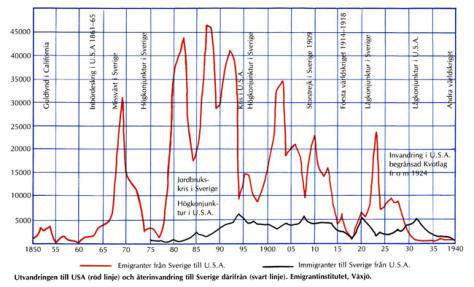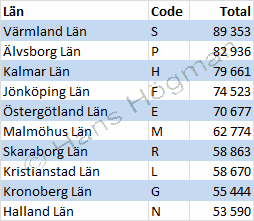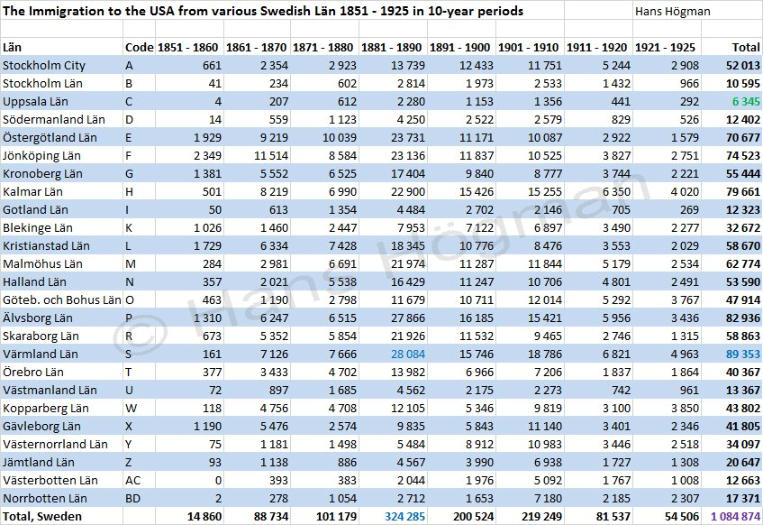
Copyright © Hans Högman 2019-12-06


Mass Emigration
A new epoch in the Swedish emigration to the
United States began after the American Civil War
(1861 – 1865). The emigration from Sweden to the
United States then changed in character. The early
emigrants were enterprising people who made the
journey to the United States either alone or
together with like-minded people. After the Civil
War began an organized mass emigration up to the
beginning of the 1930’s led to 1,200,000 emigrated
Swedes.
Before 1850 families were the core of the
emigration and this lasted only until the beginning
of the 1870’s. Thereafter the number of sole
emigrants increased but entire families still
dominated the emigration from cities. Families
constituted about 30 to 40% of the city emigrants. It
was from typical rural areas like Kronoberg Län,
Småland where sole emigrants were in majority.
The early emigration had a special character; when
you left the old farm in Sweden, there were no
turning back — the future was in the New Land.
Later a supplementary emigration arose where the
emigrants went to already established relatives in
the United States. At the end of the 19th century
the period of free homestead land was over. Then
the emigrants had to settle in already cultivated
areas or work in industry. This encouraged sole
emigration but made it tougher for family
emigration.
Peaks of Swedish Emigration
There have been three major peaks in the
emigration from Sweden to the United States:
1.
1868 – 1872
2.
1880 – 1893
3.
1901 – 1914
1868 – 1872:
The first of these peaks is attributed to the years of
famine in Sweden while at the same time there was
a boom in the United States. It was primarily the
wooded districts of the Län Kristianstad in the
South up to Kopparberg and Gävleborg in the
North that was hit by the famine in 1868. About
54,000 people emigrated between 1868 and 1869
and up to 1873 another 50,000. You have to
consider that the statistic from the 1860’s are
somewhat uncertain.
1880 – 1893:
There was a recession in the United States after
1873 which affected the emigration. In 1879 there
was crisis in the sawmill industry in Sweden at the
same time as the ironwork industry had difficulties
which caused another peak in the Swedish
emigration. Then it was primarily the struck
distressed areas that had an increased emigration.
The emigrations increased tenfold from sawmill
and forestry areas like Västernorrland Län (Mid
Sweden).
The industrialism in Sweden was very well in
progress from 1880 and ahead which meant that
crises in the the industry struck hard and affected
the emigration. At the same time there were
difficulties within farming with a downward
tendency in the prices of grain.
During the 1880’s about 325,000 Swedes emigrated
to North America and another 52,000 to other
places in the world. The top years in the emigration
were 1880 – 1882 and 1887 – 1888 when there was
a boom in the United States and a large demand
for laborers. In 1882 and 1888 about 45,000
Swedes emigrated respective year.
1901 – 1914:
There was another peak in Swedish emigration in
the beginning of the 20th century. After a smaller
decline in the 1890’s emigration then increased
again. About 35,000 emigrants left Sweden in 1903.
The numbers remained high until the outbreak of
World War I in 1914. About 20% of all Swedes then
lived in the United States.
This caused a nationwide concern in Sweden and
an Emigration Commission was appointed by the
Swedish Parliament (Riksdag) in 1907 to look into
the question. The Commission recommended
social and economic reforms to restrain the
emigration.
A general strike, the so-called Storstrejken, broke
out in 1909 in Sweden. The ongoing recession
pressured many companies and SAF (The Swedish
Employers' Confederation) planned to cut wages and
salaries in certain areas. To enforce their demands,
about 80,000 employees in textile, sawmill and
paper pulp industries were locked-out at the end of
July 1909.
The answer from LO (The Swedish Trade Union
Confederation) was a general strike in all areas; a
general strike where only public medical service
and other important social and public functions
were excluded. At most there were 300,000
laborers on strike all over Sweden (the population
of Sweden at the time was about 5 million so the
number of people on strike was large). The strike
funds were small and the trade union had to
gradually reduce the extent of the strike after only a
month. This was not popular among the strikers
and caused a widespread defection from LO (the
trade union). The employers also took advantage of
the opportunity and fired about 20,000 laborers.
This also contributed to the defection from the
trade union since there was a demand from the
companies to reemploy laborers during the
ongoing strike. The strike lasted for three months.
The emigration from Sweden increased as an effect
of the strike.
The emigration stopped entirely during WW I
(1914 – 1918) but speeded up again after 1918 with
a peak before 1924. Immigration to the United
States was reduced from 1924 due to a new
legislation in the United States which required
immigrants to obtain Visa. With Visa’s issued by US
Consulate offices in their country of origin,
questions and medical inspections were done there
at the time. Done at the Consulate, there was no
longer a need for Ellis Island and other processing
stations. The new Act also contained an immigrant
quota.
The Swedish emigration to the United States was
greatly decreased by the end of the 1920’s and
almost stopped after 1930.
The Emigration from
Sweden to the USA (3)
In the diagram, from Emigrantinstitutet in Växjö,
Sweden, we can see the peaks of the emigration
from Sweden to the USA (in red) but also the
returning emigrants (in black). We can also see
when there were times of recession respectively and
times of prosperity both in the USA and Sweden.
The chart covers the period from 1850 to 1940.

The chart above shows the emigration from
Sweden to the USA distributed per Län (region)
between 1851 and 1925. The chart shows the
number of people per decade.
The column Code shows the Län code (county code)
for respective Län.
Chart Hans Högman 2013.
Note: the space delimiter for thousands, for example
1 084 874 = 1,084,874.
See also Thousands Delimiter
and Map of the Swedish Län
The chart above is ordered by the Län Code which
means that is also ordered in geographical order
beginning in the Central east coast, down the east
side to the south of Sweden and again north on the
west side to Central Sweden. Thereafter follow the
Län in Norrland.
Län next to each other in the chart are thereby also
neighboring Län. This is the ordinary way of listing
the Län in Sweden.
If we examine the chart above we will find that the
decade that tops the emigration from Sweden is
the 1880’s when fully 324,000 Swedes emigrated.
From Värmland Län alone fully 28,000 emigrated in
the period followed by Älvsborg Län (27,866),
Östergötland Län (23,731), Jönköping Län (23,136),
Kalmar Län (22,900), Malmöhus Län (21,974) and
Skaraborg Län (21,926).
If we add together the Län in Småland province
(Jönköping Län, Kronoberg Län and Kalmar Län) we
will get 63,440 people from Småland, 49,792 from
Västergötland province and 40,319 from Skåne
province for the 1880’s.
The Län that tops the chart of emigrating
Swedes, see below, is Värmland Län with fully
89,000 emigrants during the emigration period
between 1851 and 1925. The Län with the smallest
number of emigrants is Uppsala Län with only 6,000
emigrants in the period.
The province with the highest number of
emigrants is Småland (Jönköping Län, Kronoberg
Län and Kalmar Län) with a total of 209,000
emigrants.
Map of the Swedish provinces

The emigration was remarkably sensitive to economic
fluctuations. Information sent back home about the
conditions in the United States was obviously fast and
the signals about the conditions were immediately
apprehended. This has of course to do with the large
number of Swedish emigrants in the United States.
The many letters sent back home had naturally been
in proportion to this.
Other Countries
The Swedish emigrants not only went to the United
States but with 1,200,000 emigrants it was the major
country of the Swedish emigration.
Regional Distribution of the
Emigration From Sweden
The many Swedish emigrants came from different
areas of Sweden.
During the 1870’s the emigrants came from Län like
Östergötland, Jönköping, Värmland, Kristianstad and
Kalmar. In the 1880’s Värmland and Älvsborg Län
topped the list followed by Östergötland. See the
charts below.
The charts show the emigration from Sweden to the
USA distributed per Län (region) for the 1870's and
the 1880's.
Charts Hans Högman 2013.
Map of the Swedish Län
The chart shows the top Län in the emigration from
Sweden to the USA distributed per Län (region) for
the for the entire emigration period 1851 through
1925.
Chart Hans Högman 2013.
Map of the Swedish Län

The Norrland Region was an area that during the
first half of the 1800’s had been absorbing the
surplus population from the other parts of Sweden.
Sweden has three major regions and Norrland is the
northern region and the largest (by area) of the
three. The population of Norrland doubled during
the first half of the century. After 1850, this trend
was broken at the same time the emigration from
Jämtland Län and Norrbotten Län grew, two of the
Län in Norrland. [it is Län both in singular as well as
in plural].
See Regions of Sweden and Map of the Swedish Län
Stockholm Län and the Län around Lake Mälaren
had the lowest number of emigrants had, like
Uppsala, Västmanland and Södermanland Län. Lake
Mälaren is located just west of Stockholm. The larger
cities in this area acted as a catchment area for
laborers that been laid off from farming.
It was often they who had migrated to cities that also
emigrated from the cities. Rather than returning to
farming areas they choose to emigrate if they had
difficulties finding labor and income in the cities.
Distribution According to Sex
At first, the men dominated the emigration. The
proportion between 1851 and 1870 was 70 women
to 100 men. This later developed to an increased
balance in the distribution according to sex, not the
least when the emigration from cities grew. The
surplus of women was greater there.
Plenty of Job Opportunities in the
United States
Not only agricultural workers emigrated. In the
United States there were plenty of opportunities for
everybody willing to work. America was a nation
under development and had a great need for
laborers. This need spanned to all kinds of branches
of occupations. The Midwest had a large need for
unqualified laborers. This was about the same area
that offered free homestead land. This combination
was important since it gave the settlers an
opportunity for livelihood through temporary jobs
before they had cultivated their own land and it
became productive.
The need for lumberjacks, farm workers and
unskilled laborers was huge. Railroad construction
attracted large numbers of the workforce. As railroad
constructions progressed these job opportunities
headed west.
Another type of work was offered in the Eastern
States where industries were being developed. Large
cities like Chicago also attracted a huge labor force.
As the settling of the Midwest ended, i.e. at the end
of the 19th century, it was the cities need for
workforce that tempted the laborers, both within
industry and service occupations. Newly arrived
emigrants often worked for relatives and friends who
had emigrated earlier and settled in the new country.
Most farmers / farmhands in Sweden worked in
farming during the summer and in the forests in
winter as lumberjacks. So, a great deal of the
Swedish emigrants were experienced lumberjacks
and were appreciated in the United States. For
example many Swedes worked as loggers in the
forests of Maine.
High Salaries
It was not just the job opportunities in the United
States that attracted the Swedish emigrants but also
the high salaries. The pronounced shortage of
laborers in the expanding areas of the United States
forced up the salaries. A farm hand’s salary was for
example three times as high as in Sweden. Salaries
for skilled workers like carpenters and smiths were
even higher.
When information about these salaries reached
Sweden it had a greater “pulling-effect” than any
other emigrant propaganda.
The industrial salaries were also higher than in
Sweden. On the other hand, development for better
working conditions was not as progressive as in
Sweden.
The men among the Swedish emigrants often worked
as skilled laborers like tailors, shoemakers,
carpenters and industrial workers. Their wives sewed
in the homes and the girls served as maids for the
established Americans. At the turn of the century
1900 many of the Swedish emigrants’ lived in
suburbs of the big cities with homes of their own and
in all respects had a better social environment. An
important factor to the success of the Swedes was
their calm attitude at working sites. They were
regarded loyal and hardworking people.
Germans were often considered socialists and the
Irish troublemakers. The Swedes calmer attitude
made them often attractive for employers. The so-
called "Swedish Maids" also were highly in demand.
Age and Marital Status
The emigrants were primarily all younger people. The
largest age group were those 20 to 25 years old
followed by those 25 to 30 years old.
1.
20 – 25 years old
2.
25 – 30 years old
3.
15 – 20 years old
The average age of the emigrants in other words was
remarkably low.
The marital status among the emigrants saw a shift.
It was primarily married couples with children
that emigrated during the mass emigration era. They
constituted then 61% of all emigrants. However, the
number of families later diminished. In the beginning
of the 20th century families constituted only 28%. In
other words the number of unmarried emigrants
increased, particularly the unmarried women. One
reason for this was the need for maids and servant
girls in the United States.
Social Distribution
The majority of Swedish emigrants were non-
landowners. It is estimated that about 80% of all
emigrants from farming were non-landowners.
Among these different types of farm laborers were
sons of freehold farmers, farmhands, maids, tenant
farmers (torpare), “backstugesittare”, dependent
lodgers (inhyseshjon), agricultural laborer receiving
allowance in kind (statare) and day laborers.
The non-landowners who emigrated before the end
of the 19th century were certainly attracted by the
possibility of obtaining free Homestead land in the
United States.
Casual Jobs
It was common for the settlers to take casual jobs in
the beginning. To clear the land and cultivate the
ground required money. The settlers therefore took
casual jobs to obtain necessary capital. These jobs
could, for example, be at railroad companies that
needed laborers for the many railroad construction
projects. The Swedes earned the reputation to be the
best navvies (railroad laborers). A railroad tycoon
once said, “Give me moist snuff (snus), whiskey and
Swedes and I will build a railroad to Hell”.
Another possibility for the Swedish settlers was
logging in the forest areas. The Swedes were skilled
loggers. Large forest regions were clear-cut in
Minnesota, Wisconsin and Michigan during the 19th
century. The logging was rushed but gave good
income to the loggers. However, the intensive felling
caused troublesome soil erosion which still is present
in these parts of the country.
The men handed over their settlements to the
women and went logging in the forest areas during
the first two or three winters and returned in
summer to carry on with farming.
Snus:
Snus is a Swedish moist powder tobacco product
originating from a variant of dry snuff in early 18th
century Sweden. It is consumed by placing it under
the upper lip for extended periods of time. Snus does
not result in the need for spitting. In the 19th century,
Swedish producers began to manufacture moist
snus. “Ljunglöfs Ettan” (meaning "Ljunglöf Number
One"), registered since 1822, is the oldest brand of
snus still sold. The Swedish emigrants brought the
snus to their new homeland.
The image to the right shows a
modern snus box from Ljunglöf
Ettan.
To the left is an image of a
"snusdosa" (snuff box). In
former days' snus was
bought loose, by weight.
Therefore, most people in
Sweden had a personal
“snusdosa”, small boxes
where they had their daily ration of snus. A
“snusdosa” could be made of different materials such
as silver, steel or wood. They were often engraved. I
would say that a typical snuffbox was about 3 inches
wide.
The "snusdosa" to the left might be made of silver
and is engraved. The inscription is “J. Sjöberg,
Hismofors, 1905”. Below is another name engraved
“Pål Olsson, Wånga”.
Hismofors (modern spelling Hissmofors) referes to
Hismofors village, Rödön parish, Krokom town,
Jämtland province, Sweden. J. Sjöberg is Jöns Sjöberg,
Hismofors. Pål Olsson in Wånga (Vånga) is the maker
of the snusdosa.
There was a tobacco company in the area, Krokom
Tobacco Company which manufactured snus. The
tobacco company was located in Krokom, Rödön
parish, Jämtland. The company was established in
1871 and had about 70 employees. The company
only existed for 21 years; 1871 to 1893.
The box belongs to Sonja (Carlson) Thomas in
Orlando, Florida. This "snusdosa" came to America
with her Swedish ancestors when they immigrated to
the USA.
The image is shown with consent of Sonja Thomas.
Read the full story about the snusdosa and the
Sjöberg family
Credit
Settlers who bought land owned by the railroad
companies normally did not have to make down
payments during the first two years. The settlers
were also often offered to work for the railroad
companies during that time.
The railroad companies usually owned more land
than needed for the tracks. It could be up to 15 - 20
km (15 miles) on both sides of the tracks; therefore
they sold excess land to settlers and thereby were
able to further finance their projects.
Source References
•
Source references
Top of page 




















































































































































































































































































































































































































